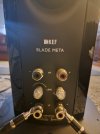cavedriver
Addicted to Fun and Learning
I don't think I disagree but if you look at the graph you linked, the 10 and 20 degree data for the KEF's is almost the same as on-axis, this is the advantage of their wide dispersion. I just re-measured my listening setup and my speakers are about 7.5 feet apart and the listener is 11 feet away for an off-axis angle of 18 degrees. This would suggest that toe-ing them in would be unnecessary. Granted I can't say right now what the problem would be with toe-ing them in right now that would encourage not doing it. People say that it puts people outside the stereo image but I've never bothered to confirm it for myself. It is interesting though when I consider measurements of B&W's where people frequently cite them for having too much high frequency output. Perhaps they also have poor off-axis response and the designers expect their listeners to not toe them in that much. Regardless this is previously hashed out terrain, pretty sure there are more informed people that could pick this apart but I can add that this reviewer isn't the only person suggesting that speaker X does not need to be, or should not be toed in.Measurements used from Erin's Audio Corner for KEF reference 1 meta.
I will make an assumption that KEF Ref 3 meta has a similar horizontal frequency response.
The response will slope even worse the further you are sitting from the speakers and if the room is highly absorptive.
As you can see the more you are sitting away from the on-axis response (speakers pointing straight ahead towards your ears), the more upper midrange and high frequency drop off. Meaning, that if you have speakers pointed straight ahead, FR will be slopped down and you will hear fewer upper frequencies.
This will make the speaker sound mellow, dull, and more relaxed (pick your word to describe the lack of upper frequencies).
Now, couple this with the aging ears (mind included and nothing personal), and you will not get the best FR, stereo image, or focus in the middle (phantom center speaker).
What you will get (and no argument from me) will be a bigger and less focused "sound stage" and a more relaxed presentation.
This will be a personal choice but if one is striving for a more accurate FR response, stereo image focus and etc, then speakers' tweeters should be crossed slightly behind one's ears ( 1-2 feet behind the MLP).


